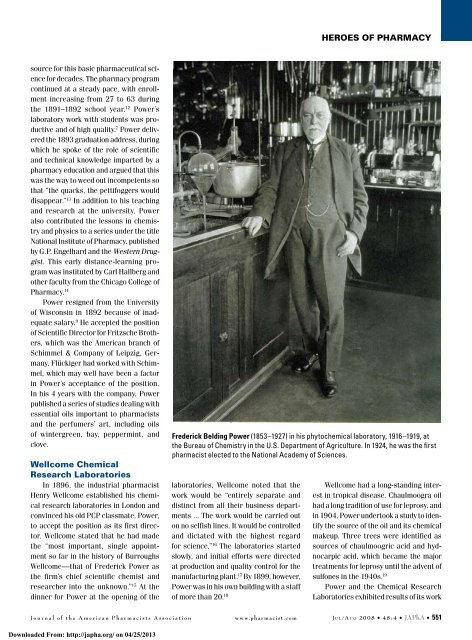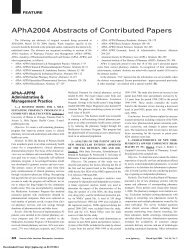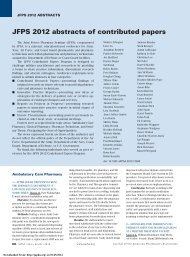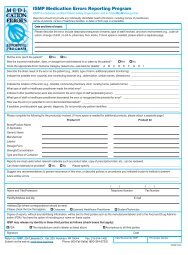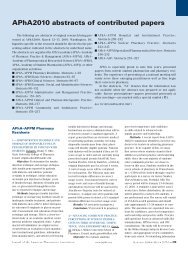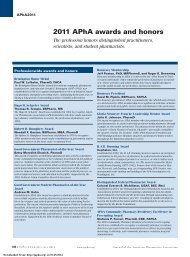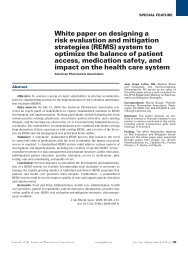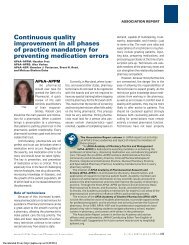frederick Belding power 1853–1927: pioneer pharmaceutical scientist
frederick Belding power 1853–1927: pioneer pharmaceutical scientist
frederick Belding power 1853–1927: pioneer pharmaceutical scientist
Create successful ePaper yourself
Turn your PDF publications into a flip-book with our unique Google optimized e-Paper software.
source for this basic <strong>pharmaceutical</strong> science<br />
for decades. The pharmacy program<br />
continued at a steady pace, with enrollment<br />
increasing from 27 to 63 during<br />
the 1891–1892 school year. 12 Power’s<br />
laboratory work with students was productive<br />
and of high quality. 7 Power delivered<br />
the 1893 graduation address, during<br />
which he spoke of the role of scientific<br />
and technical knowledge imparted by a<br />
pharmacy education and argued that this<br />
was the way to weed out incompetents so<br />
that “the quacks, the pettifoggers would<br />
disappear.” 13 In addition to his teaching<br />
and research at the university, Power<br />
also contributed the lessons in chemistry<br />
and physics to a series under the title<br />
National Institute of Pharmacy, published<br />
by G.P. Engelhard and the Western Druggist.<br />
This early distance-learning program<br />
was instituted by Carl Hallberg and<br />
other faculty from the Chicago College of<br />
Pharmacy. 14<br />
Power resigned from the University<br />
of Wisconsin in 1892 because of inadequate<br />
salary. 9 He accepted the position<br />
of Scientific Director for Fritzsche Brothers,<br />
which was the American branch of<br />
Schimmel & Company of Leipzig, Germany.<br />
Flückiger had worked with Schimmel,<br />
which may well have been a factor<br />
in Power’s acceptance of the position.<br />
In his 4 years with the company, Power<br />
published a series of studies dealing with<br />
essential oils important to pharmacists<br />
and the perfumers’ art, including oils<br />
of wintergreen, bay, peppermint, and<br />
clove.<br />
Wellcome chemical<br />
research Laboratories<br />
In 1896, the industrial pharmacist<br />
Henry Wellcome established his chemical<br />
research laboratories in London and<br />
convinced his old PCP classmate, Power,<br />
to accept the position as its first director.<br />
Wellcome stated that he had made<br />
the “most important, single appointment<br />
so far in the history of Burroughs<br />
Wellcome—that of Frederick Power as<br />
the firm’s chief scientific chemist and<br />
researcher into the unknown.” 15 At the<br />
dinner for Power at the opening of the<br />
Heroes of pHarmacy<br />
Frederick <strong>Belding</strong> Power (<strong>1853–1927</strong>) in his phytochemical laboratory, 1916–1919, at<br />
the Bureau of Chemistry in the U.S. Department of Agriculture. In 1924, he was the first<br />
pharmacist elected to the National Academy of Sciences.<br />
laboratories, Wellcome noted that the<br />
work would be “entirely separate and<br />
distinct from all their business departments<br />
... The work would be carried out<br />
on no selfish lines. It would be controlled<br />
and dictated with the highest regard<br />
for science.” 16 The laboratories started<br />
slowly, and initial efforts were directed<br />
at production and quality control for the<br />
manufacturing plant. 17 By 1899, however,<br />
Power was in his own building with a staff<br />
of more than 20. 18<br />
Wellcome had a long-standing interest<br />
in tropical disease. Chaulmoogra oil<br />
had a long tradition of use for leprosy, and<br />
in 1904, Power undertook a study to identify<br />
the source of the oil and its chemical<br />
makeup. Three trees were identified as<br />
sources of chaulmoogric acid and hydnocarpic<br />
acid, which became the major<br />
treatments for leprosy until the advent of<br />
sulfones in the 1940s. 19<br />
Power and the Chemical Research<br />
Laboratories exhibited results of its work<br />
Journal of the American Pharmacists Association www.pharmacist.com J u l /Au g 2008 • 48:4 • JAPhA • 551<br />
Downloaded From: http://japha.org/ on 04/25/2013


